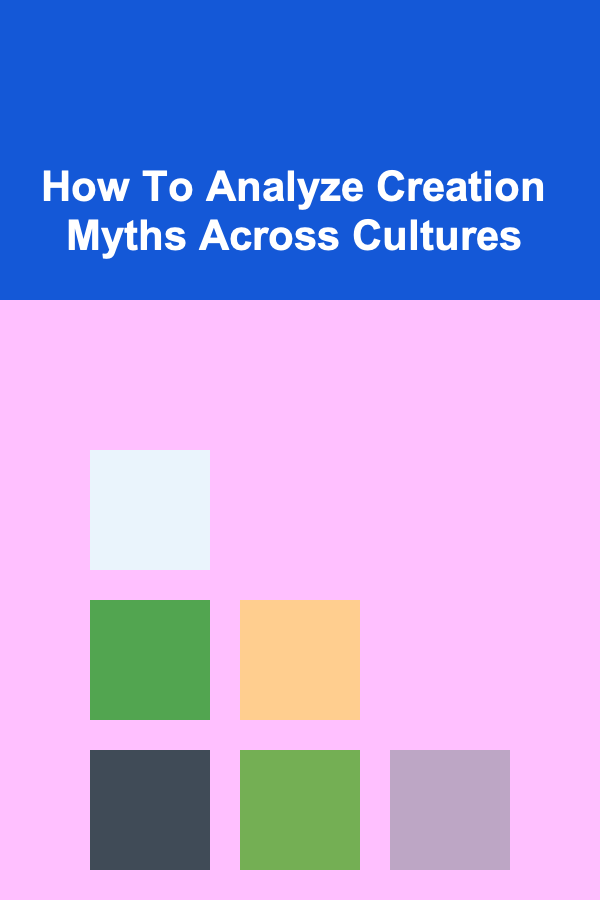
How To Analyze Creation Myths Across Cultures
ebook include PDF & Audio bundle (Micro Guide)
$12.99$6.99
Limited Time Offer! Order within the next:

Creation myths, often the bedrock of human belief systems, narrate the origins of the world, life, and the cosmos itself. These myths are not only essential to the understanding of various cultures but also serve as a lens through which we can explore the values, social structures, and worldview of different societies. From the Biblical Genesis story to the vast pantheons of the ancient Greeks and the indigenous tales of the Americas, creation myths share common themes but also exhibit stark differences. Understanding and analyzing these myths can provide profound insights into the cultures that produced them. This article delves into how to analyze creation myths across cultures, focusing on methods, themes, and the implications of these narratives.
1. Understanding Creation Myths
At their core, creation myths serve several critical functions within a culture. They explain the origins of the universe, the natural world, and humankind's place within it. They often define the relationship between humanity and the divine, as well as offer explanations for the mysteries of life, death, and existence.
Despite their diversity, creation myths tend to share certain thematic elements:
- Cosmogenesis: The story of how the universe or cosmos came into being, which may include explanations of the earth, sky, and other celestial bodies.
- Theogony: The origin of gods and their roles in shaping the universe, often illustrating the relationship between deities and humans.
- Anthropogenesis: The creation of humankind, often involving a divine act or a primordial being that molds humanity from raw elements.
Creation myths often reflect the environment, values, and psychological landscape of a culture. For example, a culture rooted in agriculture might include myths about the creation of crops and the earth's fertility, whereas a culture with a maritime tradition may have myths centered around the sea and the sky.
2. Analytical Approaches to Creation Myths
To effectively analyze creation myths across different cultures, it is crucial to consider several frameworks and methodologies that help interpret their symbolism, social significance, and cultural context.
2.1. Structuralist Approach
A structuralist approach, pioneered by scholars such as Claude Lévi-Strauss, involves looking for underlying patterns and structures within creation myths. This method seeks to identify universal motifs and themes shared across cultures, regardless of geographical or temporal differences. By comparing mythological elements such as the role of the divine, the origin of humanity, or the nature of creation, structuralists identify common patterns that reveal universal truths about human existence.
For instance, many creation myths feature a "world egg" or "cosmic womb" that gives birth to the universe. This motif is found in cultures as diverse as the ancient Chinese, Egyptian, and Indian traditions. Structuralism helps us see that these recurring themes may reflect shared human concerns about birth, origin, and the relationship between chaos and order.
2.2. Comparative Mythology
Comparative mythology compares creation myths across cultures to identify similarities, differences, and potential influences. This approach highlights the ways in which different societies address similar questions about the origins of the universe and humanity. By tracing the development of mythological themes and examining possible cultural exchanges, comparative mythology helps reveal how one myth may influence or be adapted by another.
For example, the Judeo-Christian Genesis narrative has strong parallels with the ancient Mesopotamian myth of the Enuma Elish. Both myths describe a divine creation from chaos and the shaping of humanity in the image of gods. By analyzing these connections, we can better understand the transmission of mythological ideas between cultures and their adaptation to specific cultural contexts.
2.3. Psychological Approach
The psychological approach to myth analysis draws from the theories of Carl Jung and Sigmund Freud, who argued that myths tap into the collective unconscious and express fundamental aspects of human psychology. Jung's concept of archetypes---universal, primordial symbols---helps in understanding creation myths as symbolic representations of deep-seated human fears, desires, and aspirations.
For example, the creation of a primordial being or the formation of the world from a cosmic void can be understood as psychological metaphors for the formation of the self, the birth of consciousness, or the journey of individuation. Creation myths are thus seen as ways to process and externalize the complexities of human experience, including the fear of death, the need for order, and the search for meaning.
2.4. Sociocultural Approach
From a sociocultural perspective, creation myths are reflective of the societal values, norms, and structures that existed in the culture from which they emerged. These myths can be analyzed as expressions of social order, gender roles, kinship relations, and the relationship between the individual and the community.
For instance, many creation myths involve a "chaos" or "void" that is then ordered by a divine figure. This narrative structure may reflect societal concerns with order, law, and governance. Similarly, the creation of humanity in the image of gods can be interpreted as a mythological reinforcement of social hierarchies or gender roles within a given culture. By analyzing the social functions of myths, we gain insight into the historical and political contexts in which they were created.
3. Themes in Creation Myths
While creation myths across cultures vary widely in terms of their narratives and characters, there are several recurring themes that are common to many traditions. These themes often reflect universal human concerns and experiences.
3.1. Creation from Chaos
Many creation myths begin with a state of chaos, void, or darkness. The emergence of order from this chaos is often attributed to a divine or primordial being who imposes structure on the universe. This theme symbolizes the transition from disorder to order, reflecting humanity's desire to understand and master the world around them.
In the Babylonian Enuma Elish, the god Marduk defeats the chaos monster Tiamat and creates the world from her body. Similarly, in the Greek creation myth, the primordial deity Chaos gives rise to the first gods, who then shape the cosmos.
3.2. The Role of a Creator God or Being
Creation myths frequently feature a supreme creator or a pantheon of gods who are responsible for the formation of the universe and humanity. The creator's actions can vary widely, from molding the world from raw elements to speaking it into existence. The relationship between the creator and their creation can also differ, with some myths presenting a god who is intimately involved with the world and others showing a more distant, hands-off creator.
The Abrahamic traditions portray God as a singular, omnipotent creator who forms the world through speech ("Let there be light"), whereas in Hindu mythology, Brahma is one of several deities responsible for the creation and destruction of the cosmos in cyclical time.
3.3. Creation of Humankind
The creation of humanity is a common focus in many myths. The way in which humans are created often reflects cultural ideas about the nature of humanity and the relationship between people and gods. In some myths, humans are created from the earth, as in the Judeo-Christian tradition where Adam is formed from clay, or in Greek mythology, where Prometheus molds humans from clay and water.
In other traditions, humans are created through divine sacrifice, such as in the Aztec myth where the gods' blood is used to create humanity, or in the African Yoruba tradition, where the first humans are shaped by the creator god Olodumare.
3.4. The Cosmic Struggle
Many creation myths feature a cosmic struggle or conflict between opposing forces. This conflict may be between gods, between gods and monsters, or between chaos and order. The resolution of this conflict often leads to the creation of the world or the establishment of order in the universe. These myths are a reflection of the human experience of conflict, struggle, and the desire for resolution.
The ancient Egyptian myth of Osiris involves a battle between Osiris and his brother Set, which ultimately leads to the creation of a new world order. Similarly, in Norse mythology, the gods engage in a final battle, Ragnarok, which ends with the destruction and rebirth of the world.
3.5. The Sacred Center
In many creation myths, there is the concept of a "sacred center" or a central point where the world begins. This sacred center is often a place of power, often associated with the divine. It could be the first created land, a temple, or a mountain that connects heaven and earth.
In Native American myths, for example, the creation of the world often begins at a sacred mountain, and the first humans are connected to this center. Similarly, in ancient Mesopotamia, temples were built to mark the sacred center where the gods first established order.
4. Cross-Cultural Comparisons
While creation myths often share certain structural elements, there are also significant differences in how different cultures approach the concept of creation. For example, some cultures may emphasize the primacy of order and structure, while others might focus on the fluidity and cyclical nature of creation.
The creation myth of the Aboriginal peoples of Australia, for instance, is deeply connected to the concept of the Dreamtime, a time when ancestral spirits shaped the world. This myth emphasizes the continuity of creation and the eternal nature of the world, rather than a single act of creation in the past.
In contrast, the Christian creation story emphasizes the deliberate, linear act of creation by a single, omnipotent deity, with a clear beginning and end. This reflects the Christian worldview of a purposeful universe with a definitive goal and final judgment.
5. The Enduring Legacy of Creation Myths
Creation myths, though often ancient, continue to resonate with contemporary cultures. These myths have influenced literature, art, philosophy, and religious thought throughout history. The themes of creation, order, and the divine remain relevant to modern discussions about the nature of the universe, the human condition, and the meaning of life.
Moreover, creation myths continue to be adapted and retold in contemporary forms. New Age spiritual movements, for instance, often reinterpret ancient creation myths to address contemporary concerns, such as environmentalism and the search for personal meaning. In literature and cinema, creation myths are frequently reimagined to explore issues of identity, power, and human nature.
6. Conclusion
The analysis of creation myths across cultures offers valuable insights into the diverse ways humanity has sought to understand its origins and place in the cosmos. By examining the structural patterns, symbolic meanings, and cultural contexts of these myths, we can better appreciate the universal themes that connect all human societies, as well as the unique cultural expressions that shape each tradition's worldview. Whether through a psychological, structuralist, or sociocultural lens, creation myths continue to offer profound reflections on the mysteries of life and the universe.
Reading More From Our Other Websites
- [Personal Investment 101] How to Invest in Peer-to-Peer Lending Platforms Safely
- [Home Holiday Decoration 101] How to Make Handmade Holiday Gifts That Wow
- [Organization Tip 101] How to Create a Zen Space in Your Home
- [Personal Care Tips 101] How to Exfoliate Sensitive Skin with a Facial Scrub
- [Needle Felting Tip 101] How to Produce Needle‑Felted Fashion Accessories for Runway Showcases
- [Digital Decluttering Tip 101] Must-Know Photo Organization Hacks for Every Photographer
- [Home Budget Decorating 101] How to Create a DIY Gallery Wall on a Budget: Prints, Frames, and Layout Ideas
- [Organization Tip 101] How to Use Wall-Mounted Shelves for Additional Storage
- [Whitewater Rafting Tip 101] The Meditative Power of the Current: Using Rafting to Deepen Your Daily Mindfulness Practice
- [Tie-Dyeing Tip 101] From Denim to Silk: A Fabric-by-Fabric Guide to Perfect Tie-Dye Results

Elevate Your Video Work: Advanced Skills and Best Practices for Today's Video Producer
Read More
How to Make Your Home Look More Expensive with Small Changes
Read More
How to Use Baskets and Bins for Organized Storage
Read More
How to Find Affordable Flights to Coastal Cities
Read More
How to Manage Personal Loans with Variable Interest Rates
Read More
10 Tips for Weight Loss Planning with a Busy Work Schedule
Read MoreOther Products

Elevate Your Video Work: Advanced Skills and Best Practices for Today's Video Producer
Read More
How to Make Your Home Look More Expensive with Small Changes
Read More
How to Use Baskets and Bins for Organized Storage
Read More
How to Find Affordable Flights to Coastal Cities
Read More
How to Manage Personal Loans with Variable Interest Rates
Read More